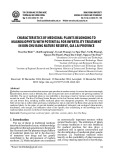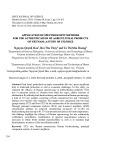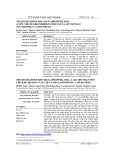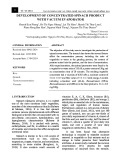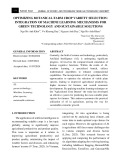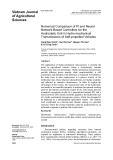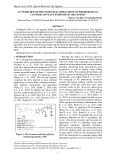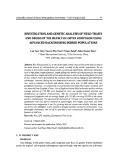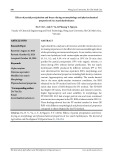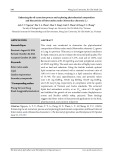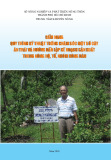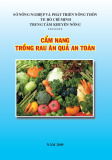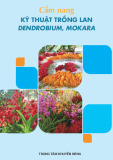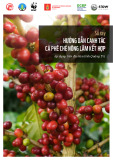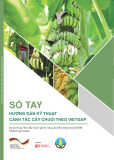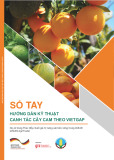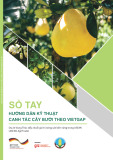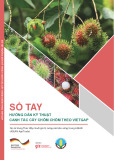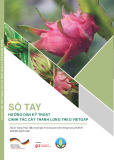
24 Nong Lam University, Ho Chi Minh City
The Journal of Agriculture and Development 23(6) www.jad.hcmuaf.edu.vn
Classification of pet owners based on knowledge attitude and practice about rabies and its
vaccination in Duc Hue, Long An province during the period 2021 - 2023
Bao D. Truong1*, Dung T. T. Nguyen1, Mai T. Duong1, Phuong H. T. To1, Son H. Ly1, Minh D. Vo1, Loan B.
P. Tr a n 1, Trang P. T. Nguyen1, Thong Q. Le1, Linh N. Nguyen2, Tuyen V. Cao3, Thanh Vo3, Oanh K. T. Vo2,
& Khanh T. M. Nguyen2
1Faculty of Animal Science and Veterinary, Nong Lam University, Ho Chi Minh City, Vietnam
2Sub-Department of Animal Health, Long An, Vietnam
3Boehringer Ingelheim Company, Ho Chi Minh City, Vietnam
ARTICLE INFO ABSTRACT
Research Paper
Received: September 11, 2023
Revised: January 14, 2024
Accepted: February 06, 2024
Keywords
Attitude
Classification
Knowledge
Practice
Rabies vaccination
*Corresponding author
Truong Dinh Bao
Email:
dinhbao.truong@hcmuaf.edu.vn
Rabies manifests is a zoonotic ailment affecting both humans and
carnivorous animals. The administration of rabies vaccination,
particularly to domesticated animals such as dogs and cats, is an
efficacious prophylactic measure for safeguarding the optimal health
of both animal and human populations. The conscientiousness of
pet owners regarding rabies vaccination significantly contributes to
the effectiveness of rabies prevention initiatives. A comprehensive
survey employing the Knowledge-Attitude-Practices framework
was undertaken among owners of dogs and cats to appraise the
efficacy of the three-year rabies vaccination program spanning
2021 to 2023 in Duc Hue district, Long An province. The primary
objectives of this inquiry were to succinctly delineate the program’s
outcomes and to gauge the evolution of awareness and behavioral
patterns among dog and cat owners. The survey adopted a
nuanced approach by categorizing participants into sub-groups,
emphasizing the differentiation of outcomes across these delineated
groups. Findings indicated that the vaccine coverage exceeded 80%
within Duc Hue, Long An province’s dog and cat population in
2023. The analytical assessment consistently identified three to
four discernible population clusters annually, based on Knowledge,
Attitude, and Practice scores, focusing on their alignment with the
overall mean within the population. Additionally, specific attention
was directed towards clusters exhibiting lower scores, with a
detailed consideration of associated variables, including commune
location and occupation. Identifying these clusters necessitates
further exploration and warrants the development of more tailored
communication and approach strategies to optimize the efficacy of
the ongoing vaccination campaign.
Cited as: Truong, B. D., Nguyen, D. T. T., Duong, M. T., To, P. H. T., Ly, S. H., Vo, M. D., Tran,
L. B. P., Nguyen, T. P. T., Le, T. Q., Nguyen, L. N., Cao, T. V., Vo, T., Vo, O. K. T., & Nguyen, K.
T. M. (2024). Classification of pet owners based on knowledge attitude and practice about rabies
and its vaccination in Duc Hue, Long An province during the period 2021 - 2023. The Journal of
Agriculture and Development 23(6), 24-37.

Nong Lam University, Ho Chi Minh City 25
The Journal of Agriculture and Development 23(6) www.jad.hcmuaf.edu.vn
population is also an important requirement for
the national plan for the prevention and control
of rabies in Vietnam (GOV, 2021).
In 2021, there were 78 animals infected with
rabies in 11 provinces. In 2022, there were 133
animals infected with rabies in 15 provinces.
From January to September 2023, 274 animals
were infected with rabies recorded in 30
provinces (DAH, 2023). In addition, the rabies
vaccination coverage within the dog and cat
population at the national level from January to
July 2023 was not high (46.27%). This rate had
a significant variation between provinces. Only
12/63 province had achieved a rate of 70%; 17/63
province had a rate varied from 50 - 69%, and 34
left had a rate of less than 50%. For public health,
378 deaths due to rabies had been recorded for
the period 2017 - 2021, with an average of 76
deaths per year. Sixty-nine deaths due to rabies
had been recorded for 2022. From January to
September 2023, 62 death cases had been notified
(DAH, 2023; NIHE, 2023).
Long An province has a relatively large land
area; people raise dogs and cats for companionship
or home guarantee, and a considerable proportion
of these animals are raised in free-range
conditions. From January 2019 to December
2022, Long An province reported seven human
fatalities attributed to rabies and 9 cases of dogs
and cats diagnosed with rabies or suspected
rabies. The majority of human deaths resulted
from dog and cat bites that were not vaccinated
due to insufficient awareness and knowledge
about rabies (DAH, 2023). Accordingly, Duc Hue
is a high-risk locality for rabies when there were
cases of rabies in humans, and the vaccination
coverage rate in recent years did not reach the
local requirements (80.00% of the animal target
population is vaccinated annually). In order
1. Introduction
Rabies is a viral zoonosis with potential
transmission of rabid animal bites, scratches,
or contact via saliva, affecting both humans and
all warm-blooded animals (Tiwari et al., 2018).
Nowadays, companion animals, particularly
dogs and cats, are not only raised for guarding
purposes but are often regarded as faithful
friends and close companions of humans (Paul et
al., 2010). This human-animal bond can provide
significant positive benefits for both mental and
physical human life (Friedmann & Son, 2009).
Therefore, there is a growing inclination towards
dogs and cats as pets. Nevertheless, there is
generally a lack of comprehensive population
data in developing countries, which elevates the
risk of rabies transmission from dogs and cats
(Gebremedhin et al., 2020). According to the
report by WHO (2023), over 40.00% of deaths
due to rabies were children under 15 years
old. Globally, approximately 59,000 people die
from rabies annually, with the majority (95%)
being in Africa and Asia due to the shortage of
post-exposure prophylaxis (PEP) services for
animal-bite victims and the lack of experienced
personnel and facilities for rabies surveillance
(Pham et al., 2021). If the preventive measures
and social awareness, especially for pet owners,
are not performed appropriately, there may
be several heightened likelihood of future
rabies outbreaks. Rabies is entirely preventable
through PEP to bite victims and is controlled
through mass vaccination of domestic dogs
(Vilas et al., 2017). Additionally, vaccination is
a cost-effective approach compared to exposure
treatment (Borse et al., 2018), and it is required
to achieve at least 70.00% of vaccine coverage,
sufficient to maintain herd immunity within
the dog population (WHO, 2019). Maintenance
of sufficient vaccination coverage in the animal

26 Nong Lam University, Ho Chi Minh City
The Journal of Agriculture and Development 23(6) www.jad.hcmuaf.edu.vn
2.2. Sampling method
The KAP surveys were conducted
collaboratively by the research team at the same
time as the implementing of the vaccination
campaign in Duc Hue district. The participants
in this study were selected through a random
sampling process, employing a sampling ratio of
1/3. This ratio dictated that one household was
included in the survey for every three households
that had received vaccinations. Determining
the number of respondents per commune
was established beforehand, considering the
proportion of households in each commune and
the calculated minimum sample size. Household
data for each commune was obtained from
the District Veterinary Station. The Statulator
software, accessible athttps://statulator.com, was
utilized to compute the minimum sample size.
The calculations were based on a confidence
interval of 95.00%, an anticipated proportion of
respondents possessing satisfactory knowledge,
attitude, and practice at 75.00%, and an absolute
error of 5.00%. Despite the initial calculation
yielding a minimum sample size of 289, a decision
was made to round it up to 300. Subsequent
adjustments to the sample size were made in
response to on-the-ground resource constraints,
resulting in two subsequent increments.
Moreover, selecting a sampling rate was
rationalized by the uncertainty surrounding
the total count and annual variations in pet
households. Aligned with the principle that
an increased sample size augments results
in representativeness, the actual number
of collected samples surpassed the initially
proposed quantity, as explicitly elucidated in the
results section.
to support the local area in controlling rabies,
the Faculty of Animal Science and Veterinary
Medicine of Nong Lam University, Ho Chi Minh
City; Boehringer Ingelheim Vietnam Company;
Long An Department of Agriculture and Rural
Development; Sub Department of Livestock
Production and Animal Health of Long An
province; along with other agencies such as
District veterinary station and communal para-
veterinaries have collaboratively initiated a
rabies vaccination campaign for the community
during the period 2021 - 2031. The program
encompassed vital activities such as vaccinating
dog and cat populations in 11 communes/
towns and raising awareness for pet households
and elementary school students using leaflets
and small performances and minigames, and
conducting a Knowledge-Attitude-Practices
(KAP) survey among owners. Understanding
the change in knowledge, attitude, and practice
is beneficial for future programs in the field,
e.g., tailoring the activities according to the
local needs to optimize the scarce resources
and provide accurate material for teaching and
learning in some related courses for students.
Therefore, the study aimed to summarize and
report the results achieved after three years of
the campaign regarding the vaccine coverage
rate, assess awareness of pet owners, and classify
them based on the data collected from the KAP
survey respondents
2. Materials and Methods
2.1. Time and location
This study was conducted in three stages:
Stage 1 from 11 to 18 April 2021, stage 2 from 16
to 22 April 2022, and stage 3 from 14 to 22 April
2023 in 11 communes/towns belonging to Duc
Hue district of Long An province (Table 1).

Nong Lam University, Ho Chi Minh City 27
The Journal of Agriculture and Development 23(6) www.jad.hcmuaf.edu.vn
2.4. Statistical data analysis
The responses to each question in the
Knowledge, Attitude, and Practice (KAP) survey
were quantified based on correctness, assigning
1 point for correct responses and 0 points for
incorrect ones or no answers. The cumulative
scores obtained in each section - Knowledge,
Attitude, and Practice were treated as distinct
active quantitative variables in the subsequent
Principal Component Analysis (PCA) to
represent the participants’ scores. The PCA and
clustering analysis (CA) methodologies were
employed to stratify pet owners longitudinally.
Specifically, PCA was applied to identify primary
components and eliminate less significant
variables in the dataset (Cornillon et al., 2012).
The analysis incorporated three primary
quantitative variables (“Knowledge,” “Attitude”
and “Practice”), supplemented by additional
quantitative variables such as “number of pets”
and “number of family members,” alongside
qualitative variables encompassing “commune
location,” “educational levels,” “gender of pet
owners,” “vaccination outcome,” and “age.”
Subsequently, CA, contingent on the PCA
and distance matrix outcomes results, was
executed to categorize these variables into
groups, considering their co-occurrence and
distances (Cornillon et al., 2012). The computer
automatically determined the optimal clusters
for each dataset to streamline the process. Both
PCA and CA were conducted utilizing the
FactoMineR package (Le et al., 2008) in the
R.4.2.1 software environment.
2.3. Methods
The study was conducted with two primary
objectives including (1) summarizing the
vaccination coverage rate in 2023 and (2)
classification of dog and cat owners over the
years 2021, 2022, and 2023 based on information
regarding their knowledge, attitude, and practice.
The first objective was to synthesize
vaccination information records from the
local District Veterinary Stations of Long An’s
Sub-DAH (DAH, 2023). The second objective
was achieved by implementing a Knowledge,
Attitude, and Practice (KAP) survey, for
which a structured questionnaire comprising
four sections was devised. The first section
encompassed demographic data and elucidated
why owners abstained from vaccinating their
pets. The second section comprised eight
inquiries about knowledge, the third section
entailed eleven questions related to attitude, and
the final section encompassed eight questions
concerning practice (see supplementary material
1). Following a thorough review and testing
by a research team member, the questionnaire
was digitally converted using the Kobotoolbox
platform (https://www.kobotoolbox.org)
to facilitate data collection through tablets
smartphones or laptops in practice. The data
collection occurred concurrently with direct
interviews conducted during the vaccination
process. The interviewers underwent training
before field data collection. Subsequently, the
acquired data was submitted and subjected to
validation on the Kobo toolbox platform. The
KAP survey was repeated for three years using
the above-mentioned procedure. Data was
encrypted and summarized automatically thanks
to the available functions of Kobotoolbox.

28 Nong Lam University, Ho Chi Minh City
The Journal of Agriculture and Development 23(6) www.jad.hcmuaf.edu.vn
3. Results
3.1. Evaluation of vaccination results in 2023
The outcomes of rabies vaccination and
the underlying reasons for non-vaccination
within the pet populations were systematically
compiled for each respective year (Table 1).
Notably, the results for the years 2021 and 2022
have been documented elsewhere (Truong et al.,
2023); therefore, the focus of this report centers
on the findings for the year 2023. Until April 22,
2023, the rabies vaccination coverage rate within
households had reached 70.00%. Considering
the entire investigated population, the overall
vaccination rate for the pet populations stood at
81.00%. The commune of My Thanh Bac exhibited
the highest percentage of vaccination coverage
rate at 89.00%, while the lowest coverage rate
was recorded in My Binh commune, amounting
to 72.00%.
Table 1. Vaccination outcomes calculated based on households and total pet population, distributed
by commune locations.
2021 2022 2023
Order Commune (1)1(2)2(3)3(4)4(1)1(2) 2 (3)3(4)4(1)1(2)2(3)3(4)4
1Dong Thanh 270 57.40 388 71.10 270 67.80 537 66.10 280 69.30 496 81.00
2
My Thanh Dong
842 53.60 1338 83.10 829 59.80 1450 74.60 873 53.50 1332 77.00
3 Binh Hoa Nam 423 52.20 1143 39.90 396 63.60 668 76.30 423 57.20 659 83.00
4 My Quy Tay 663 64.60 702 123.60 656 71.00 1207 83.30 487 85.00 1155 86.00
5 My Quy Dong 427 58.80 712 81.60 423 65.70 770 75.20 450 61.80 831 78.00
6 My Thanh Tay 412 74.80 462 128.80 427 82.00 782 83.20 460 92.60 975 81.00
7 My Thanh Bac 254 71.70 398 89.50 251 85.70 526 80.00 417 59.70 586 89,0
8 Binh Thanh 402 30.30 399 66.20 307 60.90 463 83.80 216 126.40 698 76.00
9
Binh Hoa Hung
278 51.80 572 49.70 298 56.40 365 85.20 186 74.20 s355 79.00
10 Binh Hoa Bac 414 53.40 608 71.70 409 105.90 630 89.40 455 58.00 616 87.00
11 My Binh 280 46.40 395 64.80 214 44.40 331 74.00 201 76.60 407 72.00
Total 4665 56.00 7117 77.10 4480 69.70 7729 79.10 4448 69.70 8110 81.00
1Number of dog/cat-owning households; Data provided by the District Veterinary Station before the
vaccination campaign (updated data on households after vaccination was not available for calculation);
2% of household vaccination coverage; data calculated by dividing the number of households that had pet
vaccinated for initiative data;
3Total pet population; data generated after vaccination campaigne;
4% of pet vaccination coverage; data calculated by dividing the number of pets vaccinated by total pet
population planned for vaccinating.

